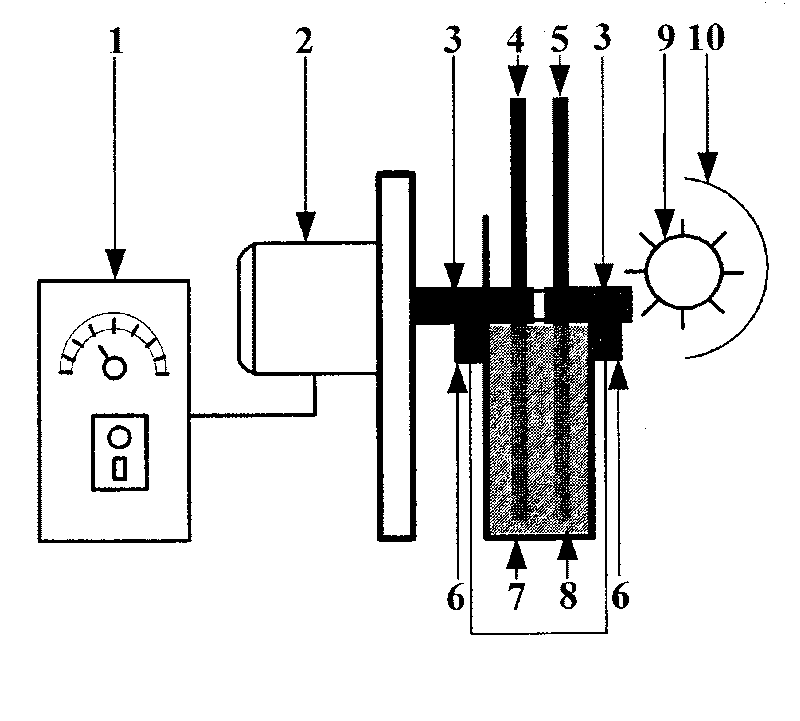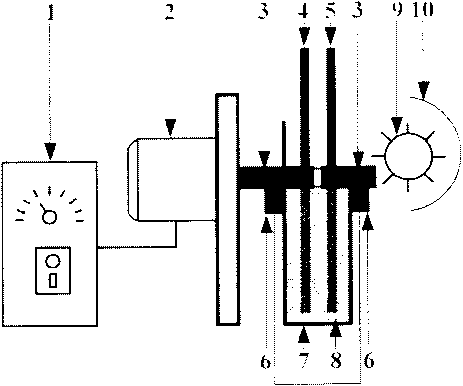Processing method for double turntable light-sensitive cell liquid membrane reactor photocatalysis organic wastewater
A technology of liquid membrane reactor and organic wastewater, applied in the direction of light water/sewage treatment, oxidized water/sewage treatment, etc., can solve the problems of increasing energy consumption, increasing energy consumption, reducing energy consumption, etc., to improve degradation efficiency, The effect of speeding up exchange updates and improving utilization
- Summary
- Abstract
- Description
- Claims
- Application Information
AI Technical Summary
Problems solved by technology
Method used
Image
Examples
Embodiment 1
[0030] Example 1 Treatment of Dye Wastewater by Double Turntable Photovoltaic Liquid Membrane Reactor with Different Cathode Materials
[0031] The treatment object is 20mg L -1 Rhodamine B (pH2.5, 1.0g / L Na 2 SO 4 ) to simulate dye wastewater. The waste water volume was 55ml.
[0032] 1) Using a titanium disc as a substrate, the TiO 2 The photocatalyst is loaded on the substrate as a photoanode, respectively fixed on the rotating shaft with the Cu, Zn, Fe or C disc cathode to form a double rotating disc, and the rotating shaft of the rotating disc is connected with the motor.
[0033] 2) Place the turntable in the semi-circular arc reaction tank, the rotating shaft of the turntable is at the water surface of the waste water, so that the lower half of the turntable is immersed in the waste water, and the photoanode and cathode turntables are connected by wires through the carbon brush connected to the rotating shaft.
[0034] 3) Start the motor, and control the rotation spe...
Embodiment 2
[0039] Example 2 TiO 2 Treatment of dye wastewater with different concentrations in a liquid membrane reactor with Ti and Cu double-rotating disk photocells
[0040] The treatment object is Rhodamine B of different concentrations (pH2.5, 1.0g / L Na 2 SO 4 ) to simulate dye wastewater. The waste water volume was 55ml.
[0041] 1) Using a titanium disc as a substrate, the TiO 2 The photocatalyst is loaded on the substrate as a photoanode, and is fixed on the rotating shaft together with the Cu disc cathode to form a double rotating disc, and the rotating shaft of the rotating disc is connected with the motor.
[0042] 2) Place the turntable in the semi-circular arc reaction tank, the rotating shaft of the turntable is at the water surface of the waste water, so that the lower half of the turntable is immersed in the waste water, and the photoanode and cathode turntables are connected by wires through the carbon brush connected to the rotating shaft.
[0043] 3) Start the mot...
Embodiment 3
[0049] Example 3 TiO 2 / Stainless steel and Cu double turntable photocell liquid membrane reactor to treat different concentrations of dye wastewater
[0050] The treatment object is Rhodamine B of different concentrations (pH2.5, 1.0g / L Na 2 SO 4 ) to simulate dye wastewater. The waste water volume was 55ml.
[0051] 1) Using a stainless steel disc as a substrate, the TiO 2 The photocatalyst is loaded on the substrate as a photoanode, and is fixed on the rotating shaft together with the Cu disc to form a double turntable, and the rotating shaft of the turntable is connected with the motor.
[0052] 2) Place the turntable in the semi-circular arc reaction tank, the rotating shaft of the turntable is at the water surface of the waste water, so that the lower half of the turntable is immersed in the waste water, and the photoanode and cathode turntables are connected by wires through the carbon brush connected to the rotating shaft.
[0053] 3) Start the motor, and control ...
PUM
 Login to View More
Login to View More Abstract
Description
Claims
Application Information
 Login to View More
Login to View More - R&D
- Intellectual Property
- Life Sciences
- Materials
- Tech Scout
- Unparalleled Data Quality
- Higher Quality Content
- 60% Fewer Hallucinations
Browse by: Latest US Patents, China's latest patents, Technical Efficacy Thesaurus, Application Domain, Technology Topic, Popular Technical Reports.
© 2025 PatSnap. All rights reserved.Legal|Privacy policy|Modern Slavery Act Transparency Statement|Sitemap|About US| Contact US: help@patsnap.com


